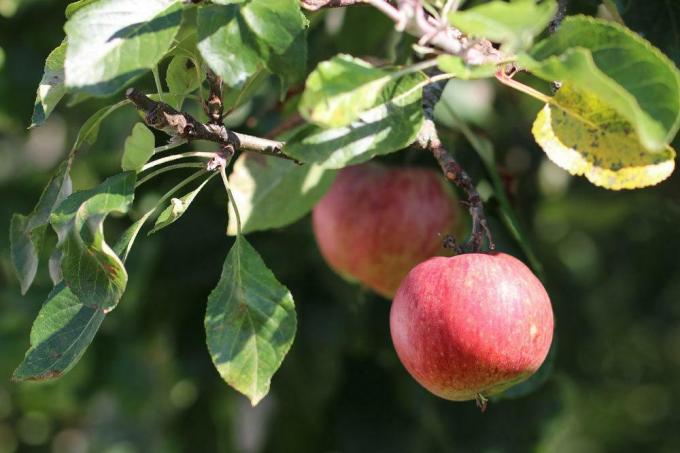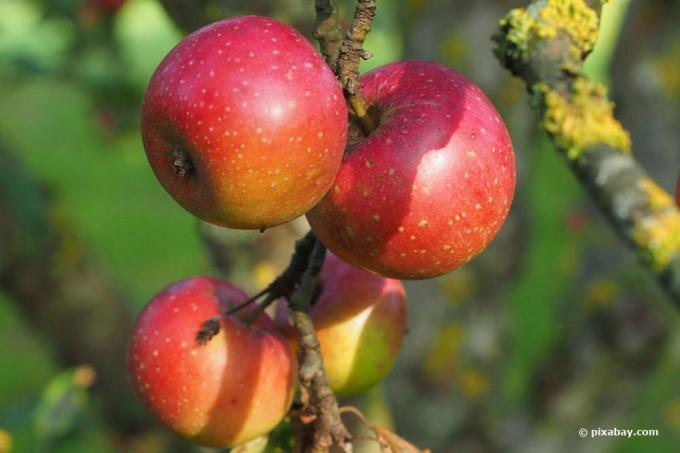
table of contents
- Apple varieties
- How many apples are there worldwide?
- Apple varieties in Germany
- Lack of variety
- Causes of the Variety Shrinkage
The apple was and is the German favorite fruit. And this is unlikely to change in the future either. Although only a handful of varieties can usually be found on the market, the number of existing varieties and also cultivated in one form or another covers a much larger range. How many apple varieties are there in Germany and worldwide?
Apple varieties
A precise determination of the species that exist worldwide is simply impossible. The reason for this is the countless cultivated forms that are added every year. They should "improve" the apple in one form or another, ie change the taste, the consistency or the shelf life in an advantageous manner. In addition, the subject of resistance to pathogens plays in today's common Monoculture cultivation an increasingly important role. Some of the new cultivars are establishing themselves while others are quickly disappearing. In addition, old traditional varieties are repeatedly forgotten and sometimes disappear completely. Finally, there is no central point that records and archives all apple varieties bred and grown around the world.
How many apples are there worldwide?
If you want to know how diverse the world of apples actually is, you have to rely on estimates. The agency responsible in Germany, the Federal Agency for Agriculture and Food, estimates the apple varieties existing around the world to be around 20,000. Other digits, on the other hand, correct this number upwards again and come to around 30,000.
Apple varieties in Germany
However, if you take a look at Germany, this number is quickly put into perspective. It is assumed that around 1,600 to 2,000 apple varieties are grown in the various kitchen gardens. The shrinkage appears even more frightening if you now focus on the economically relevant breeds:
- Only 70 varieties in commercial fruit growing
- Quantitatively significant only about 20 of them
- The majority of apples sold come from only 4 species
Lack of variety
If you remember your last visit to the supermarket or the fruit and vegetable dealer, you will notice how large the range is, but how few varieties make up the range. According to a survey by the Federal Agency for Agriculture and Food from 2015/2016, more than half of the amount sold was obtained from the following cultivars:
- Elstar (market share 17.9 percent)
- Red Prince (14.7 percent)
- Jonagored (14.5 percent)
- Braeburn (11.5 percent)
In addition, Jonagold with 8.2 percent and Gala with 7.1 percent were still comparatively close to the 10 percent mark. All other market shares of apples were significantly lower in the mid to low single digits.
Causes of the Variety Shrinkage
Anyone who knows older apple varieties from their grandparents or even from their own orchards, which were widespread until a few decades ago, will find names like
- Boskoop
- Cox orange
- Gold parmane
- White clear apple
and others still be familiar. Some of these old varieties were cultivated for centuries and had their raison d'etre at all times. The apples differed in terms of their ripeness (e.g. B. Clear apple in late spring), their shelf life (e.g. B. Boskoop in the cold cellar until the end of February) or their use (e.g. B. Cox Orange used to be the typical cake apple). These criteria hardly play a role in times of decreasing self-sufficiency and ever better, technically perfected storage options. So one can definitely come to the conclusion that the social and technical developments of the last Decades have made their contribution to the declining number of apple varieties native to Germany to have.





